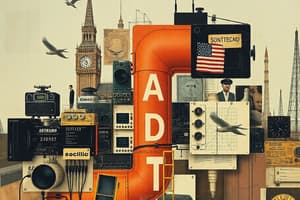Podcast
Questions and Answers
What are remote control circuits for safety control equipment classified as if they introduce a direct fire or life hazard?
What are remote control circuits for safety control equipment classified as if they introduce a direct fire or life hazard?
Class one
What type of installation is required for remote control circuits to prevent hazards?
What type of installation is required for remote control circuits to prevent hazards?
Rigid, IMC
Class one circuits are classified as either power limited circuits or what other type?
Class one circuits are classified as either power limited circuits or what other type?
Remote control and signaling circuits
What is required for conductors number 14 and larger for overcurrent protection?
What is required for conductors number 14 and larger for overcurrent protection?
Where should overcurrent devices be located?
Where should overcurrent devices be located?
Class one circuits may occupy the same cable enclosure or raceway regardless of what?
Class one circuits may occupy the same cable enclosure or raceway regardless of what?
What is the insulation requirement for conductors used in class one circuits?
What is the insulation requirement for conductors used in class one circuits?
What should be the separation distance between class two and class three circuit conductors from power and class one circuits?
What should be the separation distance between class two and class three circuit conductors from power and class one circuits?
What type of conduit is required for class two and class three circuit conductors in hoistways?
What type of conduit is required for class two and class three circuit conductors in hoistways?
What type of cables must be used for vertical runs and penetrating more than one floor?
What type of cables must be used for vertical runs and penetrating more than one floor?
What is Article 725.71 related to?
What is Article 725.71 related to?
Study Notes
Article 725 Classifications and Safety Regulations
- Class one remote control circuits pose a direct fire or life hazard if equipment fails to operate, requiring stringent safety classifications.
- Physical protection for these circuits is mandated, necessitating installation in rigid or Intermediate Metal Conduit (IMC) to prevent damage.
- Class one circuits are designated as power limited if they adhere to power limitations or as remote control and signaling circuits if utilized for those functions.
Circuit Specifications and Protection
- Class one power limited circuits must comply with specific provisions ensuring safety and efficiency.
- Overcurrent protection for conductors sized 14 and larger must align with the conductor's ampacity, without needing derating factors.
- Overcurrent devices must be situated at the point where the protected conductor receives its supply.
Conductors and Installation Regulations
- Class one circuits are allowed to share the same cable enclosure or raceway, regardless of being AC or DC, provided all conductors are insulated for the maximum voltage.
- Class one circuits may coexist with power supply circuits as long as the powered equipment is functionally associated.
- Conductor sizes 18 and 16 can be utilized if they do not exceed the ampacity limits.
Insulation and Derating Regulations
- Conductors in class one circuits must be insulated to withstand voltages of up to 600 V.
- Considerations for the number of conductors, raceway types, and derating factors are specified to ensure compliance and safety.
Class Two and Class Three Circuits
- Power sources for class two and class three circuits have specific provisions to ensure proper functionality.
- Parallel or interconnected outputs from class two or class three power sources are prohibited unless explicitly listed and approved.
- Transformers or devices fed by electric light or power circuits must have overcurrent protection rated no more than 20 A.
Installation Guidelines
- Conductors must be installed away from electric light, power circuits, class one circuits, and broadband communication cables to minimize interference.
- In hoistways, class two and class three circuit conductors require installation in rigid metallic conduit, IMC, or EMT.
- A minimum separation of two inches is mandated for conductors of class two and class three circuits from any electric light, power, or class one circuits.
Mixing of Circuits and Cable Specifications
- Multiple class two circuits are permitted within the same cable or raceway, promoting efficient use of space while ensuring compliance.
- Cables installed in ducts, plenums, and other air-handling spaces must follow specific installation requirements to maintain environmental safety.
- Vertical cable installations penetrating multiple floors must utilize CL2R or CL3R cable types, with similar requirements for floor penetrations.
Cable Listing and Marking
- The regulations encompass the listing and marking of class two, class three, and type PLTC cables, stipulating adherence to Article 725.71 for compliance.
Studying That Suits You
Use AI to generate personalized quizzes and flashcards to suit your learning preferences.
Description
Explore the critical aspects of Article 725 related to remote control circuits for safety control equipment. This quiz focuses on understanding the classification of these circuits and terms like physical protection and safety. Perfect for students looking to deepen their knowledge in electrical safety standards.




